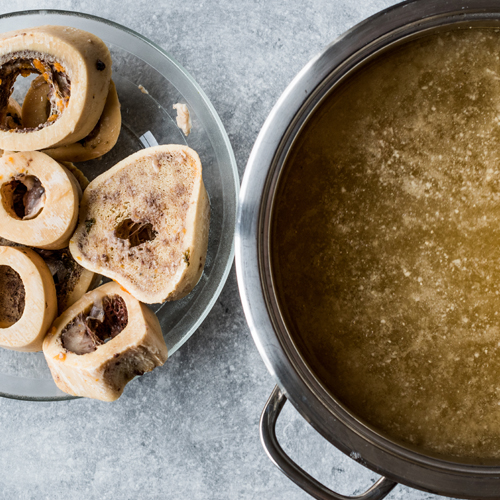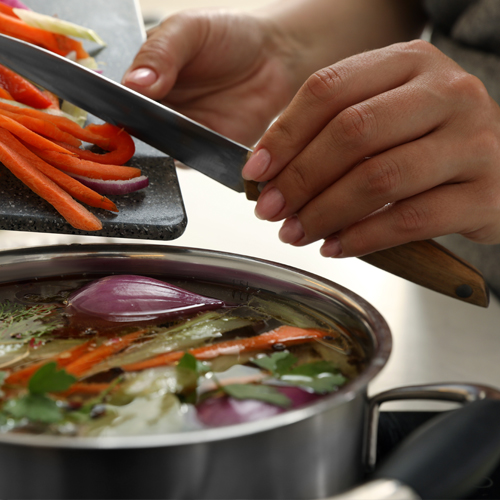
It’s All About That Base
Just like with other scenarios, a solid base can make or break a soup. Don’t get us wrong, you can still make a recipe and call it soup with a bland, uninspiring liquid. But don’t you deserve more than a basic base?
Although we are above making such assessments, some may say your investment in creating a crave-worthy, write-an-editorial-about-it, soup base could parallel the level of self-love you have. We would never “steep” so low, but some may…
Let’s leave the naysayers to focus on better things, shall we? And make you the best soup base aficionado the world has seen. Okay, maybe that’s a bit bold. Let’s just get you thinking outside the bouillon cube.
Ingredient #1: Liquid

Pretty obvious, right? But is it? Sure, you can start with water. What if you began with all-ready-made stock? Not broth, but stock. Why stock? Because the flavors tend to be more concentrated and there are much lower sodium options available.
If you’re looking for a liquid with a bit more oomph than the average broth or stock, opt for bone broth. Bone broth (either store bought or one made at home by cooking down leftover rotisserie chicken, ham or beef bones in water, slowly for a handful of hours) provides a thicker texture, thanks to the proteins being released during the cooking process.
Liquids like pureed tomatoes, coconut milk, cow’s milk and wine make delightful liquid additions as well. Just time their addition into the pot right. For example, adding cow’s milk too early in the cooking process and high heat could break the casein and whey proteins into little wiggly-looking threads while negating any velvety texture you were going for. Nobody has time for that.
Ingredient #2: Flavor

Go past a basic mirepoix (onion, celery and carrot)— don’t skip it, just pick it up on the way to your culinary destination. Add in other aromatic vegetables like fresh garlic, shallots, ginger, celeriac, turmeric, mushrooms and fennel. Play with the flavor of fresh and dried herbs such as parsley, oregano, rosemary, cilantro, basil, lemongrass and marjoram.
Get spicy with, well, spices. Go beyond black pepper and raise your flavor bar. Use whole spices earlier in the cooking process and ground varieties toward the end. Get brave and bold and play with spices like white pepper, cayenne pepper, curry, cinnamon, nutmeg and clove.
Note: When cooking with whole spices and herbs, consider creating a bouquet garni by wrapping them together in cheesecloth tied with butcher string or simply using a spice sachet. This way you can include their flavors without stems, leaves and whole spices.
Ingredient #3: Texture

Shooting for a velvety experience, or something more than clear broth? Put on your chef’s apron, it’s about to get fancy.
One option is adding pureed beans. That’s right! What a delightful, albeit sneaky way to get your family to enjoy dried beans, peas and lentils. Plus, it’s a fat-free, protein-rich option. What’s not to love?
Miso (soy protein paste) and silken tofu added to your base are two other, plant-powered stir-ins you can make as well.
Making a cream-based chowder that’s just not thickening up enough? Add a cornstarch slurry to the (almost) finished product. Since the proteins in corn starch will recoil at the heat of your soup, you must mix it with cold water so the protein strands can expand and thicken your base without breaking into clumps. Mix your slurry into your pot of soup and watch the liquid begin to gently coat your spoon while slowly stirring. If you’re not seeing a change in a minute or so, add more slurry until you reach your preferred consistency. You don’t want to be the one who serves clumpy chowder, so get slurring.
For considerably more thickening than you would see with a slurry, make a roux. You can either create a roux immediately after sautéing aromatic vegetables before adding liquids or later in the game like the cornstarch slurry.
Roux is created with any fat and flour combined in a 1 to 1 ratio. The darker the broth you’re making, the darker you may want to consider the roux. The longer you keep the roux overheat, the darker the flour will become and the nuttier its flavor. Simply heat your fat over medium to medium-high heat and stir or whisk in flour. Continue stirring until you see the combination thicken. Turn your heat down if you notice clumping or a burning smell from the flour. Mix in the liquid when creating a roux with your aromatics, until clumps melt away or mix the roux into your almost finished soup. When adding roux at the end, you want to bring your soup back to a gentle boil so the flour protein accepts the liquid to plump up and smooth out the base.
Reviewed 12/12/2023


